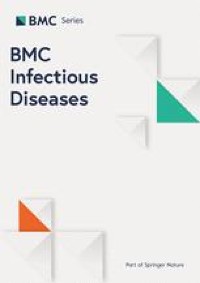Infection
Dialister pneumosintes and aortic graft infection – a case report
D. pneumosintes is well established as a cause of periodonitis and gingivitis in humans but reports of infection at other sites are sparse [4]. A PUBMED search for D. pneumosintes case reports produced twelve results of extra-oral infection (reference 9 reports on two patients), including orbital cellulitis and sinusitis, as well as pneumonia and empyema, liver and brain abscesses [5,6,7,8,9,10,11,12, 15,16,17]. In seven of the twelve cases D. pneumosintes was isolated from blood culture, suggesting haematogenous spread with a tendency for distal abscess formation. Three report polymicrobial infection; one identified mixed anaerobic infection with P. micra, as isolated in our case. However, there are no previous reports of aortic graft infection, other vascular infection, or indeed infection associated with other prosthetic material. D. pneumosintes has been isolated from lower in the gastrointestinal tract, in gastric and colorectal mucosal biopsies, stool samples and intraabdominal drain fluid [18,19,20,21]. This case highlights a novel case of bacteraemia with concurrent aortic graft infection with D. penumosintes. Whether this was caused by AEF with resultant aortic graft infection and bacteraemia, or whether distal seeding from periodontal infection led to graft infection and erosion to AEF is debatable.
Identification of D. pneumosintes is difficult with routine culture techniques as it is a slow growing obligate anaerobe. Therefore, current publications likely reflect a small sample of the true number of D. pneumosintes infections. Of the twelve case reports identified, only two isolated D. pneumosintes using traditional culture, compared with nine that used molecular methods (16 S rRNA gene sequencing or whole genome sequencing). Molecular methods have the added benefit of increased sensitivity following exposure to antimicrobial therapy. Unfortunately, we did not have the capacity to test the surgical material from explantation, or dental samples which would have proven source, with 16 S PCR for D. pneumosintes.
Literature reports suggest D. pneumosintes may be resistant to antibiotics commonly used for polymicrobial GI infections such as fluroquinolones, vancomycin, colistin and macrolides [21,22,23]. Our isolate was, unsurprisingly, resistant to vancomycin and linezolid. Although all positive blood cultures in the UK will have susceptibility work up, this highlights the importance of antimicrobial susceptibility testing on severe infections, especially those caused by unfamiliar bacteria.
In 2020, the Management of Aortic Graft Infection (MAGIC) group developed a clinical/surgical, radiological and microbiological list of criteria, which are classified into major and minor, to help suspect and diagnose vascular graft infections (Table 2) [24]. Our patient fits these criteria with a CT scan 11 months after aortic graft insertion showing gas in peri-graft collections. The positive blood cultures and fevers are minor criteria. This registry provides useful management of infected aortic grafts and highlights gaps in current knowledge. Of note, our case underwent explantation of the original vascular graft with placement of an extra-anatomical prosthetic graft. In Sect. 7.2.3 of the MAGIC guidelines, re-infection rates using this technique are quotes as 0-15%, and in smaller series the rate is up to 27%. However, there is no overall consensus as to antimicrobial therapy duration, with some research advocating up to one year of antimicrobial therapy post-op. We opted for 6 weeks post-op of antibiotics and 6 months of fluconazole.
To conclude, we report a case of aortic graft infection and AEF caused by mixed oral flora including D. pneumosintes, AEF are often difficult to diagnose and prompt recognition is vital to reduce the risk of devastating consequences. Polymicrobial abscess without other explanation in a patient with a vascular graft lead to investigation for AEF. In this case the absence of overt acute dental infection suggests that fistula may have led to local infection with subsequent bacteraemia and distal emboli. D. pneumosintes alone was isolated from anaerobic blood culture by traditional culture methods, prior to antimicrobial exposure; S. anginosus, F. nucleatum and P. micra were isolated from distal septic emboli in the lower limbs. Suggestions for future research into microbiological association with aortic graft infection include patient’s dental hygiene and buccal flora, as well as length of antimicrobial therapy following explantation and replacement of extra-anatomical prosthetic graft.

